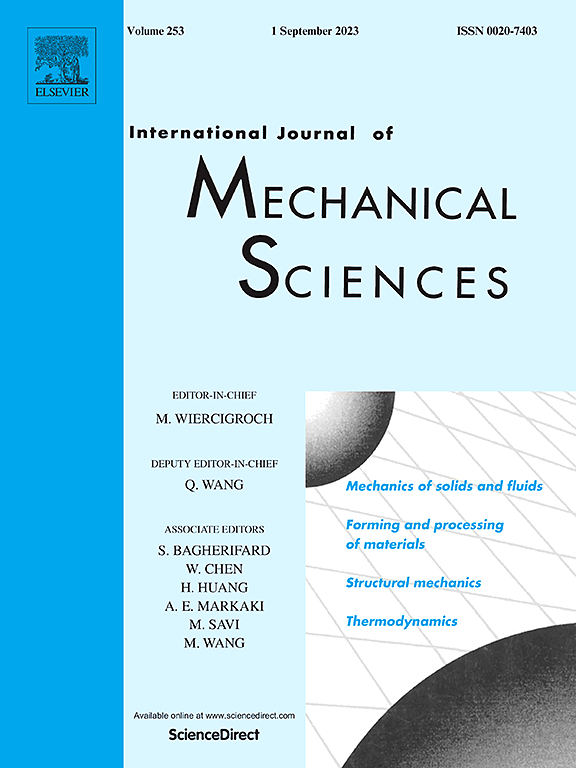奥氏体钢辐射诱导韧脆转变的原子学研究
IF 7.1
1区 工程技术
Q1 ENGINEERING, MECHANICAL
International Journal of Mechanical Sciences
Pub Date : 2025-07-15
DOI:10.1016/j.ijmecsci.2025.110567
引用次数: 0
摘要
中子辐照在结构合金中促进缺陷聚集,从而抑制塑性并引发韧脆转变(DBT),这是限制核材料抗断裂能力的关键降解机制。本研究探讨了辐照Fe-Ni-Cr合金中这种转变的断裂机制。利用分子动力学模拟,我们研究了不同缺陷类型对裂纹扩展和能量耗散机制的影响。结果揭示了这些缺陷的不同作用:空洞通过降低局部内聚能促进裂纹扩展,而位错环作为阻碍裂纹扩展和改变裂纹路径的屏障,显著改变了裂纹形态。在将断裂能分解为脆性解理和塑性组分的经典方法的基础上,本研究将分解适用于辐照材料。该框架量化了表面能和塑性功在不断增加的辐射损伤水平中不断变化的贡献,为辐照缺陷如何控制断裂动力学提供了关键的见解。本文章由计算机程序翻译,如有差异,请以英文原文为准。

Atomistic study of radiation-induced ductile-to-brittle transition in austenitic steel
Neutron irradiation in structural alloys promotes defect clustering, which suppresses plasticity and triggers a ductile-to-brittle transition (DBT), a key degradation mechanism limiting fracture resistance in nuclear materials. This study investigates the fracture mechanisms underlying this transition in irradiated Fe–Ni–Cr alloys. Using Molecular Dynamics simulations, we examine how different defect types influence crack propagation and energy dissipation mechanisms. The results reveal distinct roles of these defects: voids facilitate crack growth by reducing local cohesive energy, while dislocation loops act as barriers that impede crack advancement and redirect crack paths, significantly altering crack morphology. Building on the classical approach of separating fracture energy into brittle cleavage and plastic components, this study adapts the decomposition to irradiated materials. This framework quantifies the evolving contributions of surface energy and plastic work across increasing radiation damage levels, providing critical insight into how irradiation-induced defects govern fracture dynamics.
求助全文
通过发布文献求助,成功后即可免费获取论文全文。
去求助
来源期刊

International Journal of Mechanical Sciences
工程技术-工程:机械
CiteScore
12.80
自引率
17.80%
发文量
769
审稿时长
19 days
期刊介绍:
The International Journal of Mechanical Sciences (IJMS) serves as a global platform for the publication and dissemination of original research that contributes to a deeper scientific understanding of the fundamental disciplines within mechanical, civil, and material engineering.
The primary focus of IJMS is to showcase innovative and ground-breaking work that utilizes analytical and computational modeling techniques, such as Finite Element Method (FEM), Boundary Element Method (BEM), and mesh-free methods, among others. These modeling methods are applied to diverse fields including rigid-body mechanics (e.g., dynamics, vibration, stability), structural mechanics, metal forming, advanced materials (e.g., metals, composites, cellular, smart) behavior and applications, impact mechanics, strain localization, and other nonlinear effects (e.g., large deflections, plasticity, fracture).
Additionally, IJMS covers the realms of fluid mechanics (both external and internal flows), tribology, thermodynamics, and materials processing. These subjects collectively form the core of the journal's content.
In summary, IJMS provides a prestigious platform for researchers to present their original contributions, shedding light on analytical and computational modeling methods in various areas of mechanical engineering, as well as exploring the behavior and application of advanced materials, fluid mechanics, thermodynamics, and materials processing.
 求助内容:
求助内容: 应助结果提醒方式:
应助结果提醒方式:


